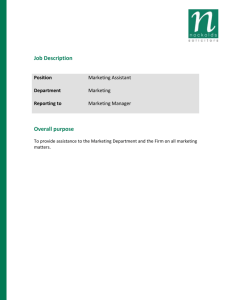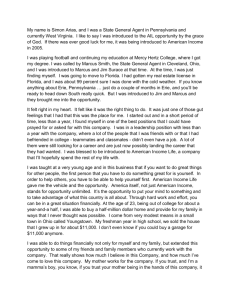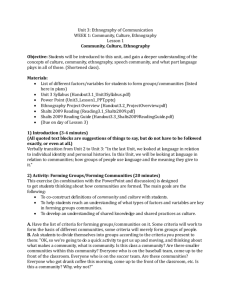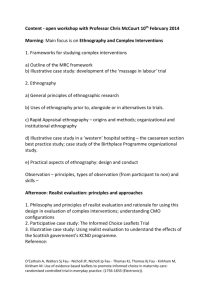commentary part 1
advertisement
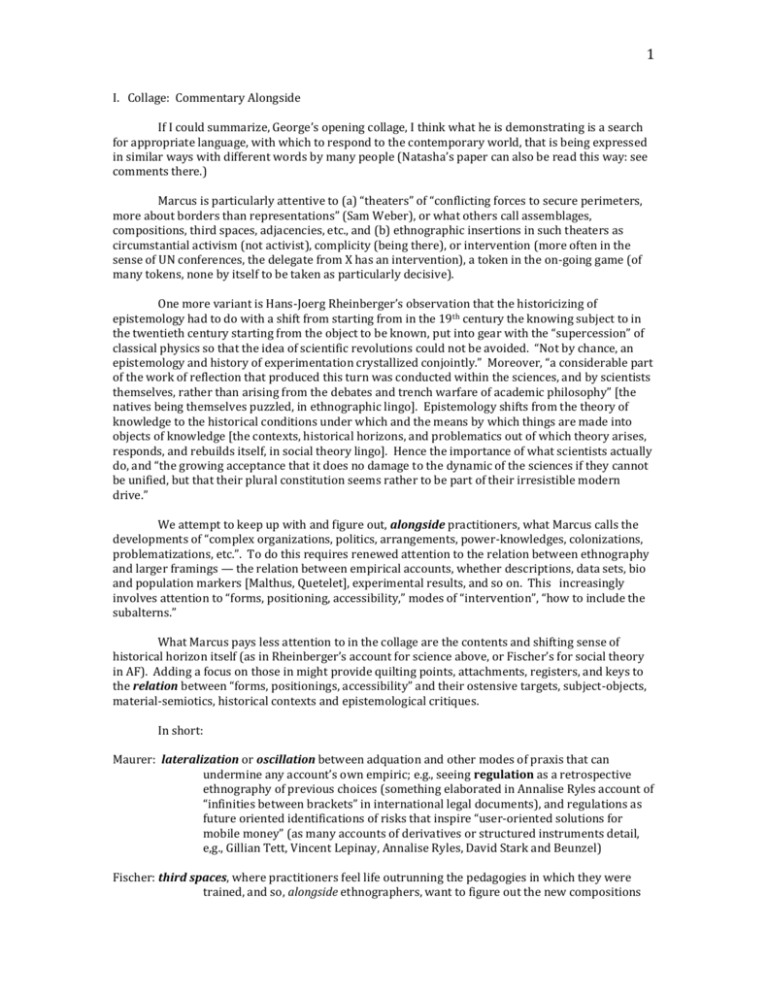
1 I. Collage: Commentary Alongside If I could summarize, George’s opening collage, I think what he is demonstrating is a search for appropriate language, with which to respond to the contemporary world, that is being expressed in similar ways with different words by many people (Natasha’s paper can also be read this way: see comments there.) Marcus is particularly attentive to (a) “theaters” of “conflicting forces to secure perimeters, more about borders than representations” (Sam Weber), or what others call assemblages, compositions, third spaces, adjacencies, etc., and (b) ethnographic insertions in such theaters as circumstantial activism (not activist), complicity (being there), or intervention (more often in the sense of UN conferences, the delegate from X has an intervention), a token in the on-going game (of many tokens, none by itself to be taken as particularly decisive). One more variant is Hans-Joerg Rheinberger’s observation that the historicizing of epistemology had to do with a shift from starting from in the 19th century the knowing subject to in the twentieth century starting from the object to be known, put into gear with the “supercession” of classical physics so that the idea of scientific revolutions could not be avoided. “Not by chance, an epistemology and history of experimentation crystallized conjointly.” Moreover, “a considerable part of the work of reflection that produced this turn was conducted within the sciences, and by scientists themselves, rather than arising from the debates and trench warfare of academic philosophy” [the natives being themselves puzzled, in ethnographic lingo]. Epistemology shifts from the theory of knowledge to the historical conditions under which and the means by which things are made into objects of knowledge [the contexts, historical horizons, and problematics out of which theory arises, responds, and rebuilds itself, in social theory lingo]. Hence the importance of what scientists actually do, and “the growing acceptance that it does no damage to the dynamic of the sciences if they cannot be unified, but that their plural constitution seems rather to be part of their irresistible modern drive.” We attempt to keep up with and figure out, alongside practitioners, what Marcus calls the developments of “complex organizations, politics, arrangements, power-knowledges, colonizations, problematizations, etc.”. To do this requires renewed attention to the relation between ethnography and larger framings — the relation between empirical accounts, whether descriptions, data sets, bio and population markers [Malthus, Quetelet], experimental results, and so on. This increasingly involves attention to “forms, positioning, accessibility,” modes of “intervention”, “how to include the subalterns.” What Marcus pays less attention to in the collage are the contents and shifting sense of historical horizon itself (as in Rheinberger’s account for science above, or Fischer’s for social theory in AF). Adding a focus on those in might provide quilting points, attachments, registers, and keys to the relation between “forms, positionings, accessibility” and their ostensive targets, subject-objects, material-semiotics, historical contexts and epistemological critiques. In short: Maurer: lateralization or oscillation between adquation and other modes of praxis that can undermine any account’s own empiric; e.g., seeing regulation as a retrospective ethnography of previous choices (something elaborated in Annalise Ryles account of “infinities between brackets” in international legal documents), and regulations as future oriented identifications of risks that inspire “user-oriented solutions for mobile money” (as many accounts of derivatives or structured instruments detail, e,g., Gillian Tett, Vincent Lepinay, Annalise Ryles, David Stark and Beunzel) Fischer: third spaces, where practitioners feel life outrunning the pedagogies in which they were trained, and so, alongside ethnographers, want to figure out the new compositions 2 of new emergent forms of life/ life forms and ecologies of interdependencies which need testing, proving grounds, ethical plateaus [see also Rabinow’s in the space of ELSI] (or striated and stratified terrains of inequality and intersecting technologies that embed decision-making, so that actions/decisions leave legible traces in institutional legacies and complications, and where as Holmes say the place of the ethnographer is anticipated; Riles: recursive and collateral knowledge, collateral being “institutions, objects, documents, persons, legal technologies, ideas,” but always along-side, separated from, colateral (Maurer’s lateralization;); she stresses the lack of knowledge of the various technicians of legal forms about content, math, etc. [viz. also, Holmes on Lepinay] Holmes: curiosity of the practitioners/natives parallels [lateral, alongside] that of ethnographers (and so the role of the ethnographer is now anticipated) especially re. sensitivity to informal culture [viz. Fischer’s “peopling of technologies” and the experimentation by central banks with communicative practices under the aegis of transparency in order to shape/manipulate the anticipatory power of expectations on markets [compare M. Fortun, Sunder Rajan on promissory logics]; he is interested in Lepinay’s account of compartmentalized knowledges [viz. Riles’ technical] in merchant banks; there is still a hint of Evans-Pritchards justification for social anthropology as knowing the structural articulations, the systemic whole, in ways that natives don’t (the Ueber Native); Fortun: digital platforms for articulating, assembling, building, composing [see also Kelty] disparate knowledges, data bases, contributions from different kinds of people, different modes of knowing, as paralleling and collaborating with scientists whose modes of doing science are transformed by huge databases that need to be cross-related to generate hypotheses in toxic worlds that cannot be contained by testing one chemical at a time; thus asthma files [evoking intersections of technologies that embed, and often hide, ethical plateaus or terrains of already decided choices that could be otherwise: e.g., the forensic, the bureaucratic, the computer; Sunder Rajan: experimental ala Rheinberger: not wild, but highly disciplined production of the new not just in science, but also in experiments with new public-private institutions, transformations of institutions and scientific competitions by new machines/technologies of high throughput analysis; and modes of translational medicine (bench to market, bench to community, etc. – i.e. different value orientations) Kelty: composition, fieldwork as epistemological encounter [see Marcus & Fischer, ACC; Rheinberger above; Fortun], platform for conceptual work, computer scientists not looking back to academic theory but to akwardly working out in practice, experimentally, immanent critique of government/ governance, recursively [also Riles], recursive public spheres Josh Clark – prototyping (to expose weaknesses in project design) Rabinow: adjacent (collateral, alongside), untimely (critical distance from the present), attention to fast/slow operations, chronicle changes, segregation of functions (entrepreneurial managers, technicians, implementers); lab meeting as space of authorized criticism of detail, technique, conception that parallels (alongside, collateral) working with grad students; positioning ethnography in the space of ELSI 3 Marcus: politics of research is much defined by positioning, and “double-agency/voicedness, alongside two streams of framing, critical purpose, conceptual language and expectations that must be ethically managed” i.e, “circumstantial activism” (but not activist) II. Installations, Design Studios, Theaters/Charismatic seminars, Para-sites, Back Channels - Arab-Israeli negotiators brought together secretly, made to play each other’s roles, in order to expose the structures & logics of positiontaking - Bringing the parties of the Acheh civil war to Harvard (as neutral 3rd space) - Bringing Chinese and Indian intellectuals together in Chicago (at the Center for Transnational Studies) - Center for Ethnography para-site events - James Hart Dyke, “A Year With M16”, Mount Street Gallery, London. III. WTO – Meditations on “An Imaginary Installation/Exhibition in the Main Halls of the Centre William Rappard, WTO HQ, Geneva”
